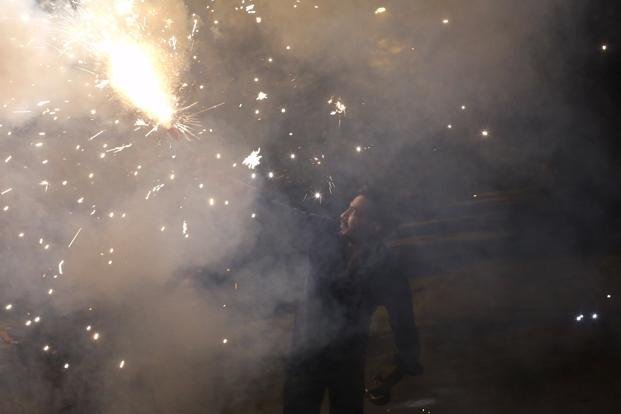The Gloom and Doom of FIrecrakers
Diwali, the most important of the thousands of festivals celebrated in India, is a festival of lights. It is often marked by resplendent dottings in the sky and countless luminous artful bursts of colors. The deep moorings of religion in a country with a population of 1.3 billion are manifested exorbitantly in its enthralling celebration of festivals. The bursting of firecrackers on the holy festival of Diwali is more of a norm than tradition, something that has swept into the mainstay of the culture and has seemingly obliterated a more subtle underlying message on which the entire festival hinges, "light over darkness".
Ironically, the festival of lights has more than a billion people choking in its aftermath.
Consider this :
Data recorded by monitoring stations show that the levels of toxins that can accumulate in humans, animals, and plants, jump three to four times the average levels of October and November (India).
In 2003, Khaiwal Ravindra and his two colleagues at the department of environmental sciences and engineering at Guru Jambeshwar University studied the effect of firecrackers on the air quality of Hisar City in Haryana during Diwali. They found a clear link—the levels of sulfur dioxides increased tenfold while that of nitrogen oxides and particulate matter increased two to three folds.
Similar studies have been undertaken by scientists from the Meghnad Saha Institute of Technology in Howrah, All India Institute of Hygiene and Public Sanitation, Kolkata, and Jadavpur University. They too recorded an exponential spike in pollution.
The gunpowder used in the roughly 240 million pounds of fireworks bought for Independence Day releases about 50,000 metric tons of carbon dioxide. Based on estimates from the EPA, a forest fire in the continental U.S. produces 18 metric tons of carbon per acre. So the amount of carbon emissions from all Fourth of July fireworks is about equivalent to the amount of carbon produced by a single 2,700-acre wildfire in the continental United States.
An NOAA study found that particulates in the air increase by 370 percent around July 4, jumping daily averages by 42 percent.
So, it can be established that firecrackers certainly exacerbate an already squalid state of order. But the question is - How much?
July 4 fireworks emit the equivalent of 50,000 metric tons of carbon dioxide into the atmosphere. That’s a lot, but it’s still small potatoes in the grand scheme of things — the U.S. emits nearly seven billion tons of CO2 annually. Contrast this with India, we produced about 1.83 billion metric tons of CO2 in 2012. So, it really is a drop in a bucket but, the important but is the rapid surge in pollution in a very short period of time.
It is not about the after-effects of smoke after it has wafted up and disseminated in the air but the after-effects it has when it is looming in the atmosphere still.

The chemicals used in firecrackers :
Copper: Irritates the respiratory tract.
Cadmium: Leads to anemia by reducing the capacity of blood to carry oxygen.
Zinc: Can cause metal fume fever and induces vomiting.
Lead: Harms the nervous system.
Magnesium: Metal fume fever is caused by Magnesium fumes.
Sodium: It is a highly reactive element and caused burns when it is combined with moisture.
It isn’t only about the ever-mounting CO2! In the US (population of 327 million) itself, there are about 25 million people with asthma. Scale that to the population of India and you’ll see troubling that is.
Besides :
There is increasing recognition of the detrimental effect of urban air pollution on human health both in the long- and in the short term.
Adults exposed to high levels of ambient air pollution have shown an increased prevalence of a chronic cough, phlegm, and breathlessness.
An increased risk of developing respiratory symptoms, asthma, chronic obstructive pulmonary disease (COPD), allergic rhinitis, lower respiratory tract infections, and lung cancers.
A 2007 study by the Meghnad Saha Institute of Technology in Howrah, which was restricted to the Howrah area, revealed an increase in the incidence of cardiovascular mortality and morbidity of 125% and 175%, respectively. There are other studies that concur :
In the 2014 study, ‘Potential Impact of Fireworks on Respiratory Health’, in Lung India, a peer-reviewed journal of the Indian Chest Society, Caroline Gouder and Stephen Montefort wrote: “Adults exposed to high levels of ambient air pollution have shown increased prevalence of a chronic cough, phlegm, and breathlessness and are, therefore, at an increased risk of developing respiratory symptoms, asthma, chronic obstructive pulmonary disease, allergic rhinitis, lower respiratory tract infections, and lung cancers.”
A 2007 study, ‘Recreational Atmospheric Pollution Episodes: Inhalable Metalliferous Particles from Firework Displays’, published in Atmospheric Environment, had found that children were susceptible in particular since their defenses against particulate matter and other gaseous air pollutants were weaker. Also, children engaged in greater physical activities, increasing the intake of polluted air into their lungs.
Furthermore, standard noise level set by the Department of Environment and Natural Resources (DENR) for the ambient environment is 60 dB during daytime and 50 decibels during night time. Fireworks can be loud and can exceed 140 decibels. Noise at 85 decibels above can damage hearing.
Not to mention there hardly is enough area to burst those crackers safely, and when they are often lit without any account for safety.

Much like it is with smoking in public, the consequences of your actions need not be borne by others. You can’t really enjoy at someone else’s expense.
